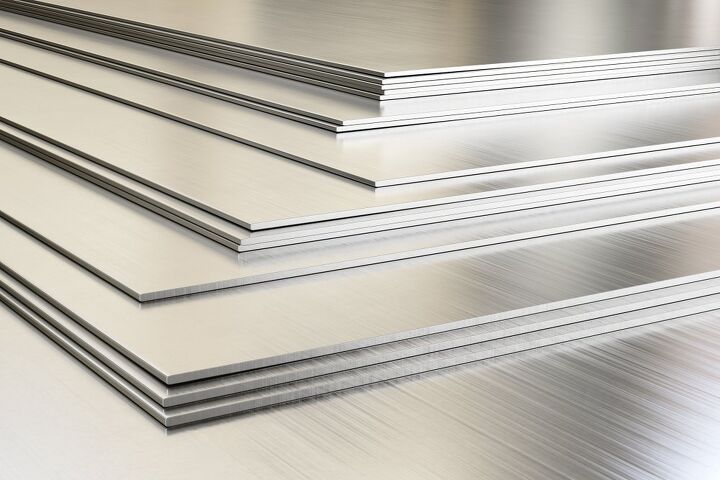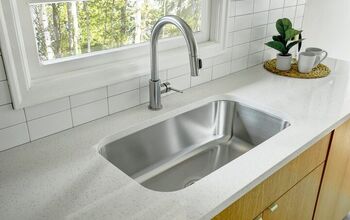Chrome Vs. Stainless Steel: What Are The Major Differences?

Choosing between chrome and stainless steel can be a hard choice depending on what it is you are choosing it for. Stainless steel or chrome is often chosen when it comes to furniture, bathroom and kitchen fixtures, building materials, doorknobs, and even car parts.
Stainless steel is more durable and long-lasting than chrome, but chrome is cheaper. Chrome is notable for the polished look, but it can tarnish faster than stainless steel. It is easier to clean stainless steel because it can handle chemical cleaners, but chrome is sensitive.
Chrome is a modern and shiny look with a blueish tone, and it looks great in a white room or with cool colors. Being the cheaper choice also makes it a better material when putting it on your fixtures throughout your home. But stainless-steel lasts much longer and once the protective coating of chrome is gone, it will rust and look bad.
What is Chrome?
Chrome is not a metal in itself. It is a coating applied to steel to protect it from the elements. There are various grades of chrome made from different types of metal. Made from chromium, which is a chemical, chrome is just a plated layer over copper, brass, aluminum, or steel. However, it is also an additive in the making of stainless steel.
For chrome plating, raw metal is polished with sanding belts and wheels to get rid of any indentions, scratches, or other dings. Then the metal is cleaned using acid, soap, and water. Sometimes a layer of copper and/or nickel is added before the chrome is applied to fill in any pits or lines.
The chrome plating vat is a warm solution where the electroplating takes place. The longer the metal is left in the vat, the thicker the plating will be. After the chrome bath, the chrome-plated metal is cleaned and polished again for a shiny and reflective surface.
How is Chrome Made?
Chrome is not actual metal, it is a layer of chromium electroplating, which is a chemical property. The plating is protective, shiny, and smooth, making it a popular choice in household building and decorating.
- Chrome actually starts out with a raw metal base, which is cleaned and degreased to remove the heavy impurities and soil. The raw metal is cleaned and polished with sanding belts as well.
- Manual cleaning is next, where the residual dirt and grease is cleaned off. Once everything is clean, the metal is treated with chemicals to help the chromium adhere to the metal.
- Next, the metal is placed in a bath of electrolytic chromium. The longer it is left in the bath, the thicker the layer of chrome. The rate is typically about 20 to 30 microns per hour.
- For decorative plating, it will be between five and eight micrometers thick. Hard plating requires between 10 and 500 microns. The thicker the plating, the stronger the result.
Decorative and Hard Chrome Plating
There are two varieties of chrome plating, the decorative chrome plating and hard chrome plating. The main difference between these two is the thickness of the plating. The decorative plating is thinner than hard chrome and is mainly for aesthetic purposes.
- Decorative chrome plating is between five and eight micrometers thick. You will typically see decorative chrome on things like:
Decorative items such as vases, jewelry, and even on shoesCutlery and kitchen utensils like spoons, forks, and knivesDoorknobs, faucets, and other fixturesAutomotive parts like grills, door handles, trim, and bumpersTools such as sockets, pliers, and wrenchesMusical instruments like flutes, clarinets, and guitars
- Hard chrome plating is applied at a lower temperature to keep from damaging the metal and for a longer time to make it much thicker than decorative chrome. The thickness of hard chrome ranges from 10 to 500 micrometers. Some of the common applications include:
Automotive engine parts like cylinders, rotors, and pistonsCompressorsMechanical equipment like lathe beds, press punchers, and mining equipmentFood, beverage, pharmaceutical, and agricultural equipmentAny high-stress industrial applications
Pros and Cons of Chrome
The Benefits of Chrome
There are benefits of chrome too though. First of all, it is very inexpensive compared to stainless steel. Also, the chrome finish can be polished to a high shine unlike stainless steel, which has a more satin look to it. With faucets and other fixtures, this polished look is popular.
Chrome is also beneficial in that it can be electroplated onto many different surfaces, not just metal. For instance, you can have plastic items coated with chrome to make a lightweight and inexpensive decoration like a vase or sculpture. Where stainless steel is very heavy, chrome is a light layer that does not add much heaviness to the object it is covering.
The Downsides of Chrome
While chrome is shinier than stainless steel, it can eventually wear off in time just from regular usage. Chrome cannot be cleaned with harsh cleaners or subjected to high heat. When the coating starts to wear off, you cannot do anything to fix it aside from getting it coated in chrome all over again.
Depending on the thickness of the chrome plating, it can be damaged easier than stainless steel. And once it is damaged or worn, the raw metal underneath is not protected (or pretty) and is subject to rust and corrosion.
What is Stainless Steel?
On the other hand, stainless steel is actually a metal, not just a plating on top of the metal. Made with several durable elements like carbon, nitrogen, aluminum, silicon, manganese, nickel, and chromium, it is one of the hardest materials to be used in many products. Some of the main uses for stainless steel include:
- Appliances like dishwashers, stoves, and refrigerators
- Medical equipment like scalpels, surgical implants, and dental crowns
- Major architecture like buildings and bridges
- The bodies of automobiles, trains, and airplanes
- Storage tanks, pipes, and valves
Stainless steel is shiny as well but does not rust or corrode like chrome will eventually do. Stainless is a solid material all the way through while chrome is just a coating over raw metal. Because it does not corrode, it can be used in any hospital or food service equipment where they use strong cleaners.
Stainless steel will last forever without wearing down because it is solid all the way through. If it ever gets scratched or damaged, it can be buffed or sanded out. You cannot do that with chrome, or it will just buff off the chrome and leave you with raw steel, which is not pretty.
How is Stainless Steel Made?
Stainless steel starts as an iron alloy made up of carbon, nitrogen, manganese, silicon, nickel, molybdenum, and chromium. These elements can be adjusted to make the end result varied for different purposes and costs.
- In making stainless steel, the materials are melted together in an electric arc furnace for 10 to 12 hours.
- Afterward, extra carbon is removed by using an argon oxygen decarburization (AOD) converter or vacuum oxygen decarburization (VOD) machine where it is also reduced and desulfurized.
- The stirring or tuning process comes next, which allows detailed adjustments to the chemical composition of the steel. It is slowly stirred to remove the elements that are not wanted and to improve consistency.
- Then, the steel is formed by pouring it into casts. The forms depend on what the stainless steel will be used for.
- Hot rolling and cold rolling come next, which includes rolling it through high temperatures and then running it through cold temperatures.
- Annealing is done to make it softer and more malleable and then it is cooled and descaled by bathing it in certain acids.
- The metal will then be cut to whatever sizes are needed. It can be sawed with high-speed blades, straight cut with guillotine knives, sheared with circular knives, or flame cut with a torch.
- After cutting, the steel is finished by grinding, sandblasting, and buffing out the dings, dents, and impurities.
Pros and Cons of Stainless Steels
The Main Benefits of Stainless Steel
While chrome can be cleaned to where it is shiny and reflective, it cannot be sterilized like stainless steel can be. Stainless steel is solid and does not need any type of coating or plating. You will not see fingerprints on stainless steel as you will with chrome either.
Stainless steel also comes in a variety of grades that give users the choice of many different finishes and strengths. This is also good in providing lower prices of stainless steel, which is the most expensive choice of household materials. It does not rust or corrode and can be sterilized, making it the number one choice for hospitals.
Stainless steel can also stand up to both high and low temperatures, which makes it good for cookware. You can use it from the oven to the freezer and back again with no worry of damage. The makeup of stainless steel allows it to actually fix itself in the case of minor scratches or dings.
The Downsides of Stainless Steel
One of the main cons of stainless steel is the price, because it is expensive. Stainless still is also much duller than shiny chrome. In addition to being less visually attractive, the metal shows visible dust and fingerprints.
Durability – Chrome vs. Stainless Steel
When cared for properly, chrome will last you many years. The material is durable in dry environments and low usage areas. Though, once the chrome coating gets penetrated, the exposed raw steel underneath is susceptible to rusting and corrosion. Unfortunately, this coating can very easily be penetrated, whether it’s from being bumped, by clamping something onto the chrome, the sharp edge of an object, or a metal tool.
Once the protective surface of chrome has been infiltrated, the corrosion and rust will spread throughout until the entire chrome layer falls off and the raw steel is fully exposed. Stainless steel, on the other hand, has been proven to be one of the most durable metals out there. It will serve you well for many years without any risk of corrosion or rust.
In fact, when something made of stainless steel is taken out of service in a medical facility, it’s because it is no longer operational or bent, not because of rust or corrosion. The high durability of stainless steel corresponds to the price.
Which is More Expensive?
When it comes to cost, stainless steel is quite a bit more expensive than chrome. The increased price has to do with the many desirable qualities that stainless steel possesses. These include, but are not limited to, durability and strength. If you’re on a budget, chrome can still be a viable choice. Though, this will depend on where you are applying the metal.
For a stainless-steel faucet, you will pay over $100 but, in most cases, you can get a chrome faucet for under $50.
How Can You Tell The Difference Between Chrome and Stainless Steel?
The easiest way to tell the difference between these two metals is to use a magnet. Simply put, if the magnet sticks to the metal, it is likely chrome since stainless steel is not magnetic. You can also distinguish chrome and stainless steel visually. Chrome has a bright, shiny finish, while stainless steel’s finish is more of a satin.
Though, it can be challenging to tell the difference solely based on appearance, as there are some finishes of stainless steel that are exceptionally shiny.

I am a DIYer who loves writing about anything home-related. When I am not writing, you can find me studying for my PhD in Psychology, photographing nature, and swimming at the lake with my grandkids.
More by Patricia Oelze



























